Nursing Care Plan for Osteoporosis and Neck of Femur Fracture Patient
VerifiedAdded on 2023/06/07
|14
|3899
|294
AI Summary
This nursing care plan is for a patient with osteoporosis and neck of femur fracture. It includes an overview of pathophysiology, wound healing, involving the patient in her own care, and nursing care and rationale.
Contribute Materials
Your contribution can guide someone’s learning journey. Share your
documents today.
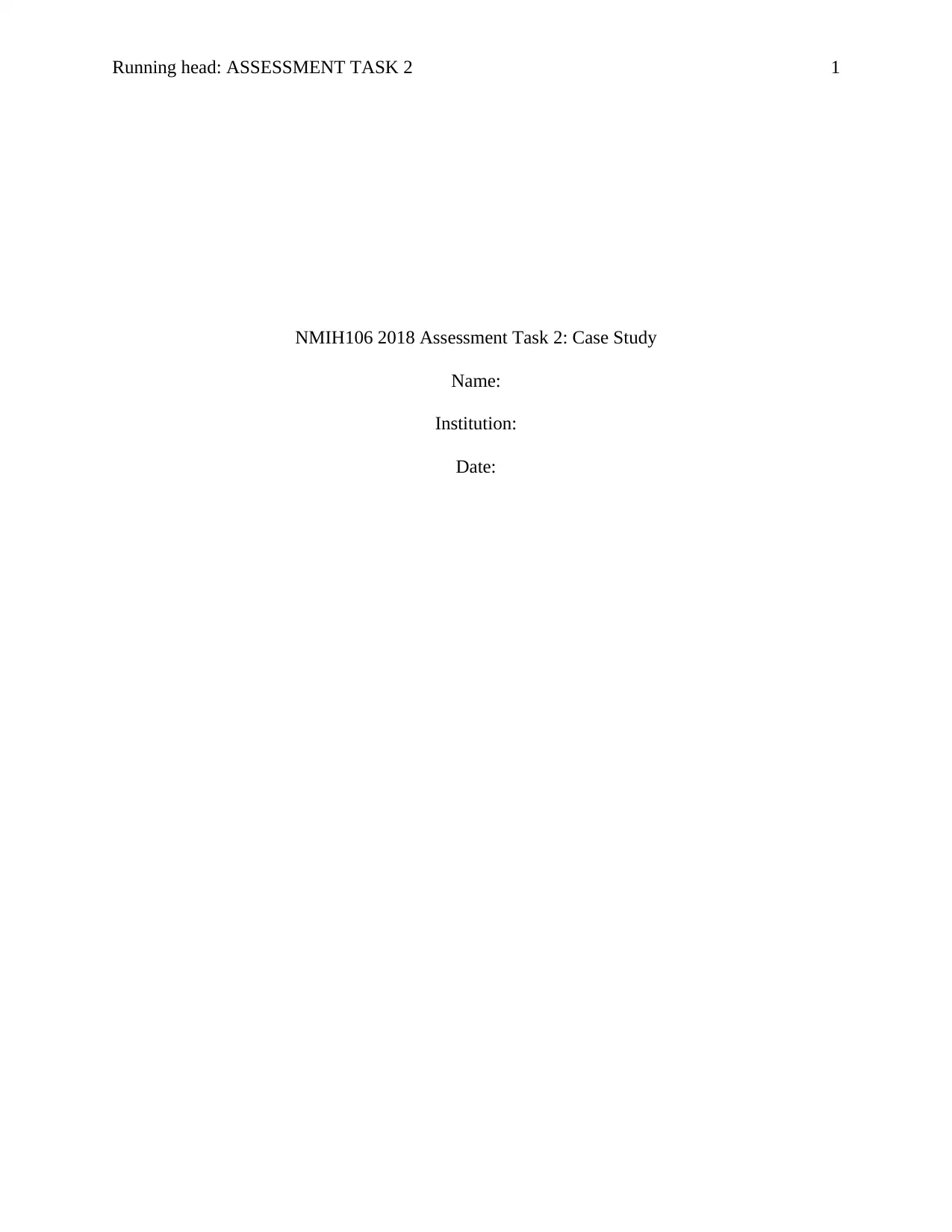
Running head: ASSESSMENT TASK 2 1
NMIH106 2018 Assessment Task 2: Case Study
Name:
Institution:
Date:
NMIH106 2018 Assessment Task 2: Case Study
Name:
Institution:
Date:
Secure Best Marks with AI Grader
Need help grading? Try our AI Grader for instant feedback on your assignments.
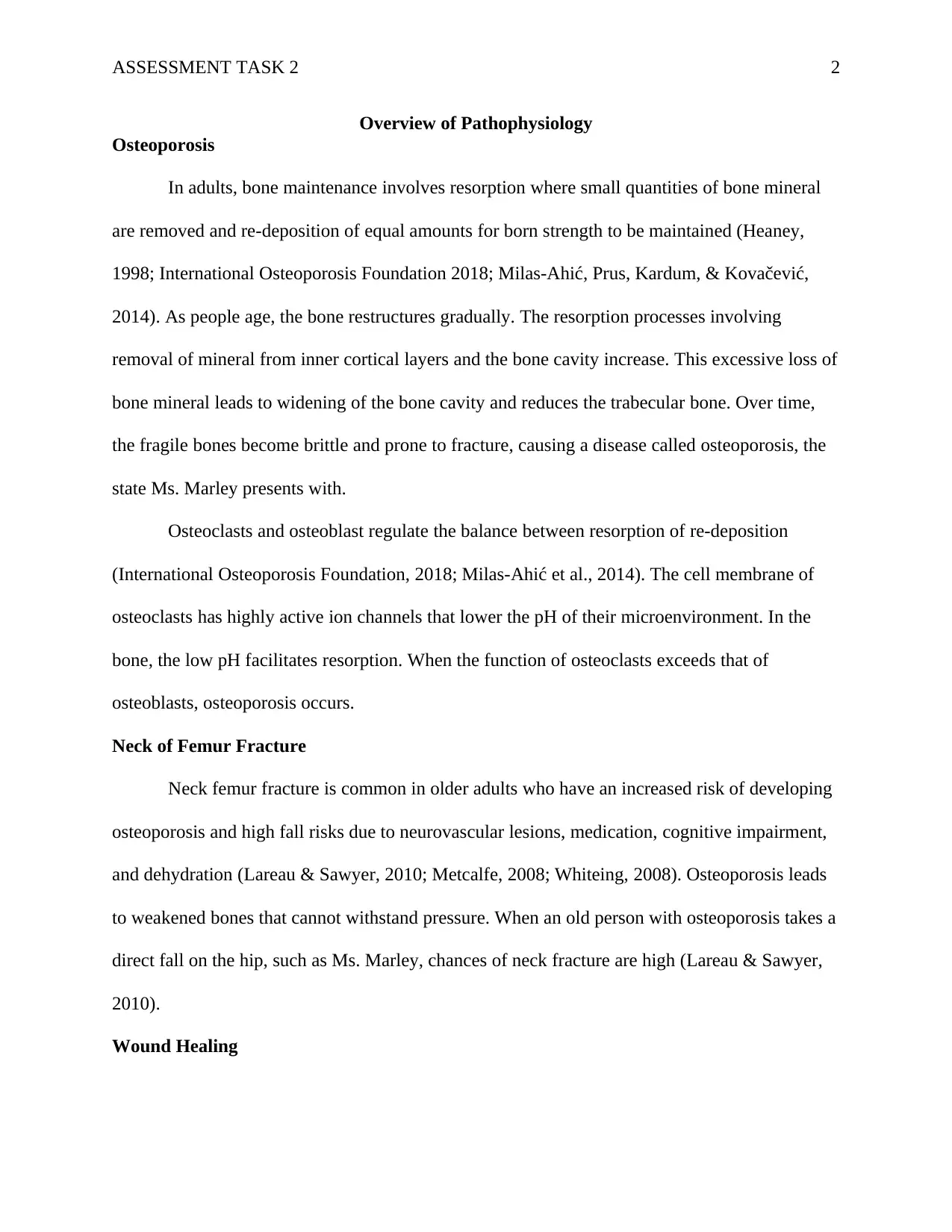
ASSESSMENT TASK 2 2
Overview of Pathophysiology
Osteoporosis
In adults, bone maintenance involves resorption where small quantities of bone mineral
are removed and re-deposition of equal amounts for born strength to be maintained (Heaney,
1998; International Osteoporosis Foundation 2018; Milas-Ahić, Prus, Kardum, & Kovačević,
2014). As people age, the bone restructures gradually. The resorption processes involving
removal of mineral from inner cortical layers and the bone cavity increase. This excessive loss of
bone mineral leads to widening of the bone cavity and reduces the trabecular bone. Over time,
the fragile bones become brittle and prone to fracture, causing a disease called osteoporosis, the
state Ms. Marley presents with.
Osteoclasts and osteoblast regulate the balance between resorption of re-deposition
(International Osteoporosis Foundation, 2018; Milas-Ahić et al., 2014). The cell membrane of
osteoclasts has highly active ion channels that lower the pH of their microenvironment. In the
bone, the low pH facilitates resorption. When the function of osteoclasts exceeds that of
osteoblasts, osteoporosis occurs.
Neck of Femur Fracture
Neck femur fracture is common in older adults who have an increased risk of developing
osteoporosis and high fall risks due to neurovascular lesions, medication, cognitive impairment,
and dehydration (Lareau & Sawyer, 2010; Metcalfe, 2008; Whiteing, 2008). Osteoporosis leads
to weakened bones that cannot withstand pressure. When an old person with osteoporosis takes a
direct fall on the hip, such as Ms. Marley, chances of neck fracture are high (Lareau & Sawyer,
2010).
Wound Healing
Overview of Pathophysiology
Osteoporosis
In adults, bone maintenance involves resorption where small quantities of bone mineral
are removed and re-deposition of equal amounts for born strength to be maintained (Heaney,
1998; International Osteoporosis Foundation 2018; Milas-Ahić, Prus, Kardum, & Kovačević,
2014). As people age, the bone restructures gradually. The resorption processes involving
removal of mineral from inner cortical layers and the bone cavity increase. This excessive loss of
bone mineral leads to widening of the bone cavity and reduces the trabecular bone. Over time,
the fragile bones become brittle and prone to fracture, causing a disease called osteoporosis, the
state Ms. Marley presents with.
Osteoclasts and osteoblast regulate the balance between resorption of re-deposition
(International Osteoporosis Foundation, 2018; Milas-Ahić et al., 2014). The cell membrane of
osteoclasts has highly active ion channels that lower the pH of their microenvironment. In the
bone, the low pH facilitates resorption. When the function of osteoclasts exceeds that of
osteoblasts, osteoporosis occurs.
Neck of Femur Fracture
Neck femur fracture is common in older adults who have an increased risk of developing
osteoporosis and high fall risks due to neurovascular lesions, medication, cognitive impairment,
and dehydration (Lareau & Sawyer, 2010; Metcalfe, 2008; Whiteing, 2008). Osteoporosis leads
to weakened bones that cannot withstand pressure. When an old person with osteoporosis takes a
direct fall on the hip, such as Ms. Marley, chances of neck fracture are high (Lareau & Sawyer,
2010).
Wound Healing
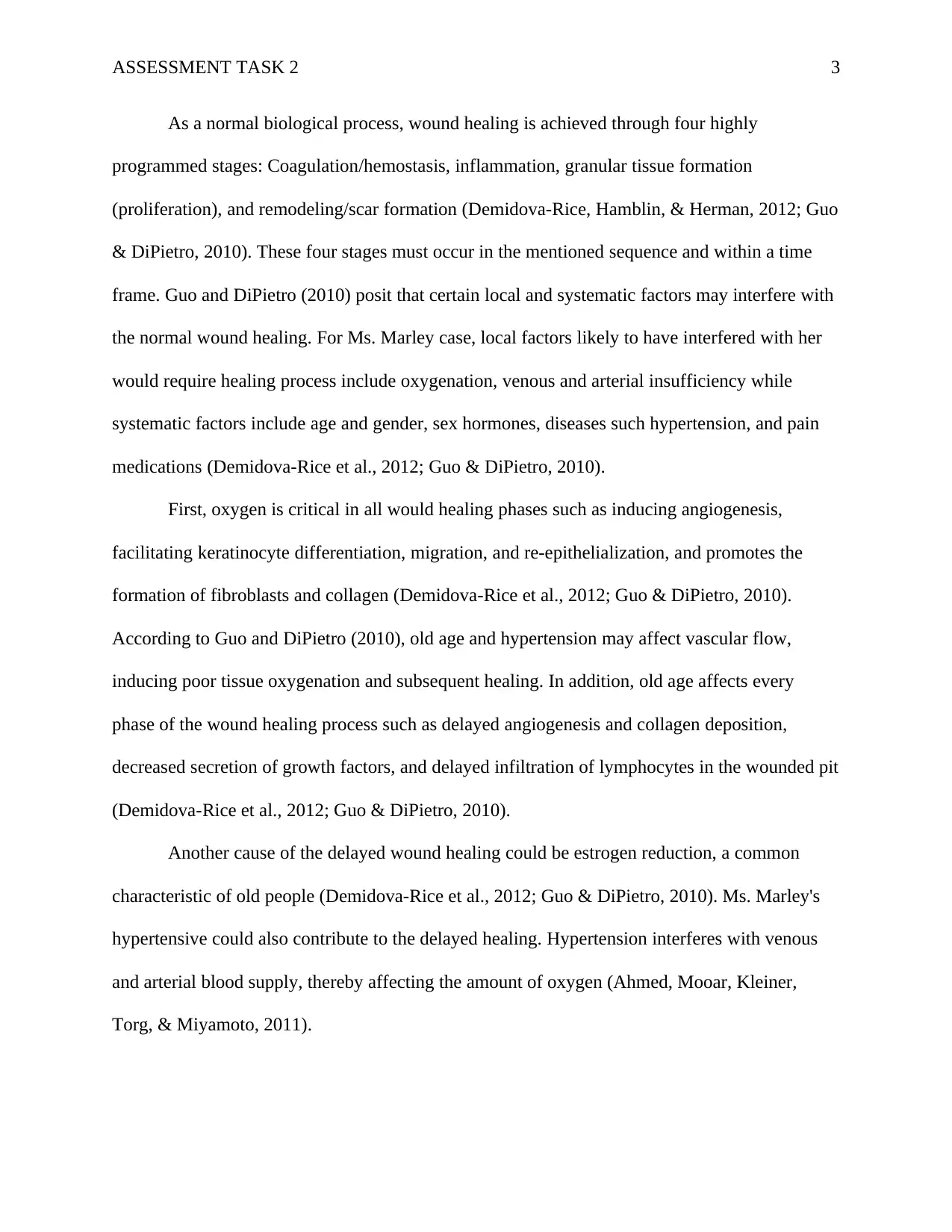
ASSESSMENT TASK 2 3
As a normal biological process, wound healing is achieved through four highly
programmed stages: Coagulation/hemostasis, inflammation, granular tissue formation
(proliferation), and remodeling/scar formation (Demidova-Rice, Hamblin, & Herman, 2012; Guo
& DiPietro, 2010). These four stages must occur in the mentioned sequence and within a time
frame. Guo and DiPietro (2010) posit that certain local and systematic factors may interfere with
the normal wound healing. For Ms. Marley case, local factors likely to have interfered with her
would require healing process include oxygenation, venous and arterial insufficiency while
systematic factors include age and gender, sex hormones, diseases such hypertension, and pain
medications (Demidova-Rice et al., 2012; Guo & DiPietro, 2010).
First, oxygen is critical in all would healing phases such as inducing angiogenesis,
facilitating keratinocyte differentiation, migration, and re-epithelialization, and promotes the
formation of fibroblasts and collagen (Demidova-Rice et al., 2012; Guo & DiPietro, 2010).
According to Guo and DiPietro (2010), old age and hypertension may affect vascular flow,
inducing poor tissue oxygenation and subsequent healing. In addition, old age affects every
phase of the wound healing process such as delayed angiogenesis and collagen deposition,
decreased secretion of growth factors, and delayed infiltration of lymphocytes in the wounded pit
(Demidova-Rice et al., 2012; Guo & DiPietro, 2010).
Another cause of the delayed wound healing could be estrogen reduction, a common
characteristic of old people (Demidova-Rice et al., 2012; Guo & DiPietro, 2010). Ms. Marley's
hypertensive could also contribute to the delayed healing. Hypertension interferes with venous
and arterial blood supply, thereby affecting the amount of oxygen (Ahmed, Mooar, Kleiner,
Torg, & Miyamoto, 2011).
As a normal biological process, wound healing is achieved through four highly
programmed stages: Coagulation/hemostasis, inflammation, granular tissue formation
(proliferation), and remodeling/scar formation (Demidova-Rice, Hamblin, & Herman, 2012; Guo
& DiPietro, 2010). These four stages must occur in the mentioned sequence and within a time
frame. Guo and DiPietro (2010) posit that certain local and systematic factors may interfere with
the normal wound healing. For Ms. Marley case, local factors likely to have interfered with her
would require healing process include oxygenation, venous and arterial insufficiency while
systematic factors include age and gender, sex hormones, diseases such hypertension, and pain
medications (Demidova-Rice et al., 2012; Guo & DiPietro, 2010).
First, oxygen is critical in all would healing phases such as inducing angiogenesis,
facilitating keratinocyte differentiation, migration, and re-epithelialization, and promotes the
formation of fibroblasts and collagen (Demidova-Rice et al., 2012; Guo & DiPietro, 2010).
According to Guo and DiPietro (2010), old age and hypertension may affect vascular flow,
inducing poor tissue oxygenation and subsequent healing. In addition, old age affects every
phase of the wound healing process such as delayed angiogenesis and collagen deposition,
decreased secretion of growth factors, and delayed infiltration of lymphocytes in the wounded pit
(Demidova-Rice et al., 2012; Guo & DiPietro, 2010).
Another cause of the delayed wound healing could be estrogen reduction, a common
characteristic of old people (Demidova-Rice et al., 2012; Guo & DiPietro, 2010). Ms. Marley's
hypertensive could also contribute to the delayed healing. Hypertension interferes with venous
and arterial blood supply, thereby affecting the amount of oxygen (Ahmed, Mooar, Kleiner,
Torg, & Miyamoto, 2011).
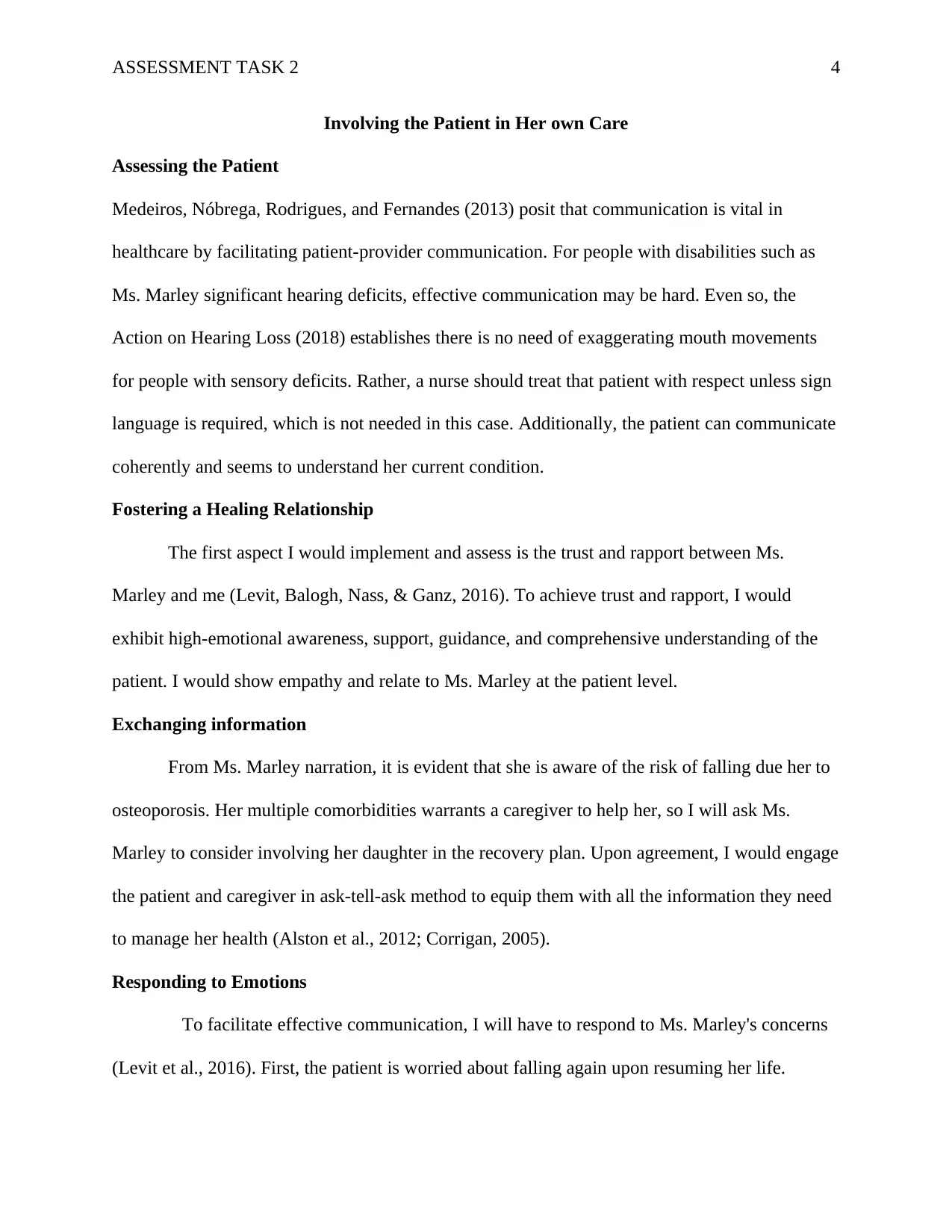
ASSESSMENT TASK 2 4
Involving the Patient in Her own Care
Assessing the Patient
Medeiros, Nóbrega, Rodrigues, and Fernandes (2013) posit that communication is vital in
healthcare by facilitating patient-provider communication. For people with disabilities such as
Ms. Marley significant hearing deficits, effective communication may be hard. Even so, the
Action on Hearing Loss (2018) establishes there is no need of exaggerating mouth movements
for people with sensory deficits. Rather, a nurse should treat that patient with respect unless sign
language is required, which is not needed in this case. Additionally, the patient can communicate
coherently and seems to understand her current condition.
Fostering a Healing Relationship
The first aspect I would implement and assess is the trust and rapport between Ms.
Marley and me (Levit, Balogh, Nass, & Ganz, 2016). To achieve trust and rapport, I would
exhibit high-emotional awareness, support, guidance, and comprehensive understanding of the
patient. I would show empathy and relate to Ms. Marley at the patient level.
Exchanging information
From Ms. Marley narration, it is evident that she is aware of the risk of falling due her to
osteoporosis. Her multiple comorbidities warrants a caregiver to help her, so I will ask Ms.
Marley to consider involving her daughter in the recovery plan. Upon agreement, I would engage
the patient and caregiver in ask-tell-ask method to equip them with all the information they need
to manage her health (Alston et al., 2012; Corrigan, 2005).
Responding to Emotions
To facilitate effective communication, I will have to respond to Ms. Marley's concerns
(Levit et al., 2016). First, the patient is worried about falling again upon resuming her life.
Involving the Patient in Her own Care
Assessing the Patient
Medeiros, Nóbrega, Rodrigues, and Fernandes (2013) posit that communication is vital in
healthcare by facilitating patient-provider communication. For people with disabilities such as
Ms. Marley significant hearing deficits, effective communication may be hard. Even so, the
Action on Hearing Loss (2018) establishes there is no need of exaggerating mouth movements
for people with sensory deficits. Rather, a nurse should treat that patient with respect unless sign
language is required, which is not needed in this case. Additionally, the patient can communicate
coherently and seems to understand her current condition.
Fostering a Healing Relationship
The first aspect I would implement and assess is the trust and rapport between Ms.
Marley and me (Levit, Balogh, Nass, & Ganz, 2016). To achieve trust and rapport, I would
exhibit high-emotional awareness, support, guidance, and comprehensive understanding of the
patient. I would show empathy and relate to Ms. Marley at the patient level.
Exchanging information
From Ms. Marley narration, it is evident that she is aware of the risk of falling due her to
osteoporosis. Her multiple comorbidities warrants a caregiver to help her, so I will ask Ms.
Marley to consider involving her daughter in the recovery plan. Upon agreement, I would engage
the patient and caregiver in ask-tell-ask method to equip them with all the information they need
to manage her health (Alston et al., 2012; Corrigan, 2005).
Responding to Emotions
To facilitate effective communication, I will have to respond to Ms. Marley's concerns
(Levit et al., 2016). First, the patient is worried about falling again upon resuming her life.
Secure Best Marks with AI Grader
Need help grading? Try our AI Grader for instant feedback on your assignments.
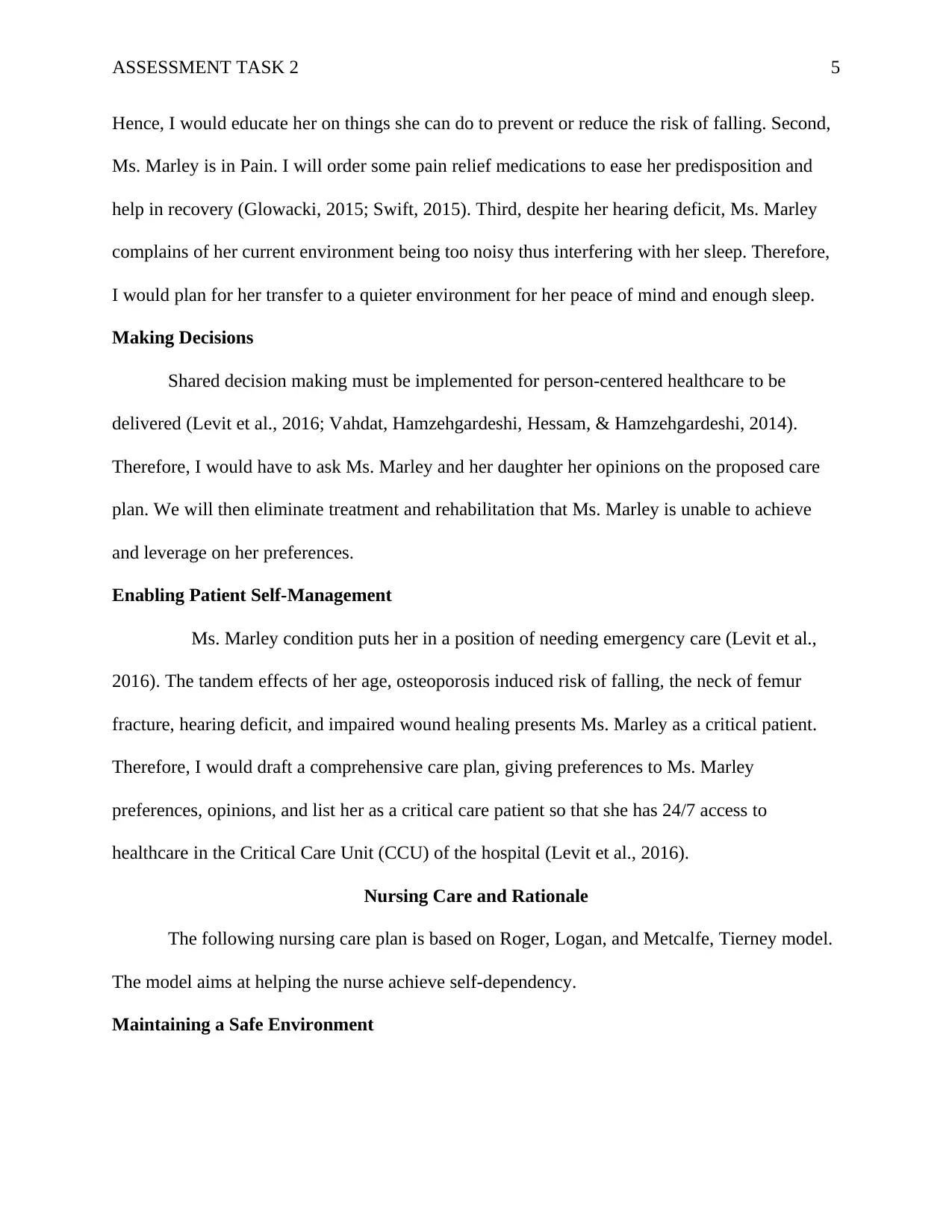
ASSESSMENT TASK 2 5
Hence, I would educate her on things she can do to prevent or reduce the risk of falling. Second,
Ms. Marley is in Pain. I will order some pain relief medications to ease her predisposition and
help in recovery (Glowacki, 2015; Swift, 2015). Third, despite her hearing deficit, Ms. Marley
complains of her current environment being too noisy thus interfering with her sleep. Therefore,
I would plan for her transfer to a quieter environment for her peace of mind and enough sleep.
Making Decisions
Shared decision making must be implemented for person-centered healthcare to be
delivered (Levit et al., 2016; Vahdat, Hamzehgardeshi, Hessam, & Hamzehgardeshi, 2014).
Therefore, I would have to ask Ms. Marley and her daughter her opinions on the proposed care
plan. We will then eliminate treatment and rehabilitation that Ms. Marley is unable to achieve
and leverage on her preferences.
Enabling Patient Self-Management
Ms. Marley condition puts her in a position of needing emergency care (Levit et al.,
2016). The tandem effects of her age, osteoporosis induced risk of falling, the neck of femur
fracture, hearing deficit, and impaired wound healing presents Ms. Marley as a critical patient.
Therefore, I would draft a comprehensive care plan, giving preferences to Ms. Marley
preferences, opinions, and list her as a critical care patient so that she has 24/7 access to
healthcare in the Critical Care Unit (CCU) of the hospital (Levit et al., 2016).
Nursing Care and Rationale
The following nursing care plan is based on Roger, Logan, and Metcalfe, Tierney model.
The model aims at helping the nurse achieve self-dependency.
Maintaining a Safe Environment
Hence, I would educate her on things she can do to prevent or reduce the risk of falling. Second,
Ms. Marley is in Pain. I will order some pain relief medications to ease her predisposition and
help in recovery (Glowacki, 2015; Swift, 2015). Third, despite her hearing deficit, Ms. Marley
complains of her current environment being too noisy thus interfering with her sleep. Therefore,
I would plan for her transfer to a quieter environment for her peace of mind and enough sleep.
Making Decisions
Shared decision making must be implemented for person-centered healthcare to be
delivered (Levit et al., 2016; Vahdat, Hamzehgardeshi, Hessam, & Hamzehgardeshi, 2014).
Therefore, I would have to ask Ms. Marley and her daughter her opinions on the proposed care
plan. We will then eliminate treatment and rehabilitation that Ms. Marley is unable to achieve
and leverage on her preferences.
Enabling Patient Self-Management
Ms. Marley condition puts her in a position of needing emergency care (Levit et al.,
2016). The tandem effects of her age, osteoporosis induced risk of falling, the neck of femur
fracture, hearing deficit, and impaired wound healing presents Ms. Marley as a critical patient.
Therefore, I would draft a comprehensive care plan, giving preferences to Ms. Marley
preferences, opinions, and list her as a critical care patient so that she has 24/7 access to
healthcare in the Critical Care Unit (CCU) of the hospital (Levit et al., 2016).
Nursing Care and Rationale
The following nursing care plan is based on Roger, Logan, and Metcalfe, Tierney model.
The model aims at helping the nurse achieve self-dependency.
Maintaining a Safe Environment
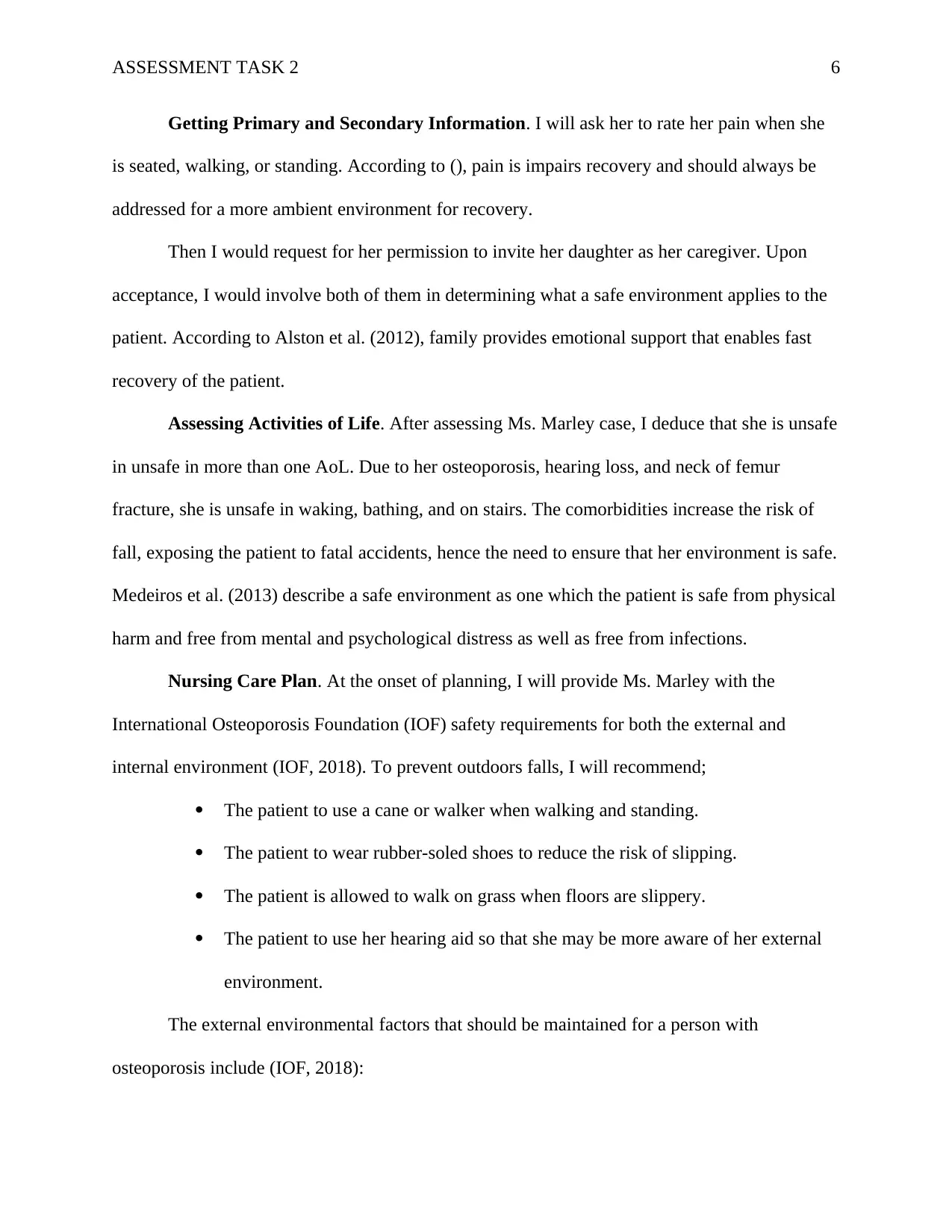
ASSESSMENT TASK 2 6
Getting Primary and Secondary Information. I will ask her to rate her pain when she
is seated, walking, or standing. According to (), pain is impairs recovery and should always be
addressed for a more ambient environment for recovery.
Then I would request for her permission to invite her daughter as her caregiver. Upon
acceptance, I would involve both of them in determining what a safe environment applies to the
patient. According to Alston et al. (2012), family provides emotional support that enables fast
recovery of the patient.
Assessing Activities of Life. After assessing Ms. Marley case, I deduce that she is unsafe
in unsafe in more than one AoL. Due to her osteoporosis, hearing loss, and neck of femur
fracture, she is unsafe in waking, bathing, and on stairs. The comorbidities increase the risk of
fall, exposing the patient to fatal accidents, hence the need to ensure that her environment is safe.
Medeiros et al. (2013) describe a safe environment as one which the patient is safe from physical
harm and free from mental and psychological distress as well as free from infections.
Nursing Care Plan. At the onset of planning, I will provide Ms. Marley with the
International Osteoporosis Foundation (IOF) safety requirements for both the external and
internal environment (IOF, 2018). To prevent outdoors falls, I will recommend;
The patient to use a cane or walker when walking and standing.
The patient to wear rubber-soled shoes to reduce the risk of slipping.
The patient is allowed to walk on grass when floors are slippery.
The patient to use her hearing aid so that she may be more aware of her external
environment.
The external environmental factors that should be maintained for a person with
osteoporosis include (IOF, 2018):
Getting Primary and Secondary Information. I will ask her to rate her pain when she
is seated, walking, or standing. According to (), pain is impairs recovery and should always be
addressed for a more ambient environment for recovery.
Then I would request for her permission to invite her daughter as her caregiver. Upon
acceptance, I would involve both of them in determining what a safe environment applies to the
patient. According to Alston et al. (2012), family provides emotional support that enables fast
recovery of the patient.
Assessing Activities of Life. After assessing Ms. Marley case, I deduce that she is unsafe
in unsafe in more than one AoL. Due to her osteoporosis, hearing loss, and neck of femur
fracture, she is unsafe in waking, bathing, and on stairs. The comorbidities increase the risk of
fall, exposing the patient to fatal accidents, hence the need to ensure that her environment is safe.
Medeiros et al. (2013) describe a safe environment as one which the patient is safe from physical
harm and free from mental and psychological distress as well as free from infections.
Nursing Care Plan. At the onset of planning, I will provide Ms. Marley with the
International Osteoporosis Foundation (IOF) safety requirements for both the external and
internal environment (IOF, 2018). To prevent outdoors falls, I will recommend;
The patient to use a cane or walker when walking and standing.
The patient to wear rubber-soled shoes to reduce the risk of slipping.
The patient is allowed to walk on grass when floors are slippery.
The patient to use her hearing aid so that she may be more aware of her external
environment.
The external environmental factors that should be maintained for a person with
osteoporosis include (IOF, 2018):
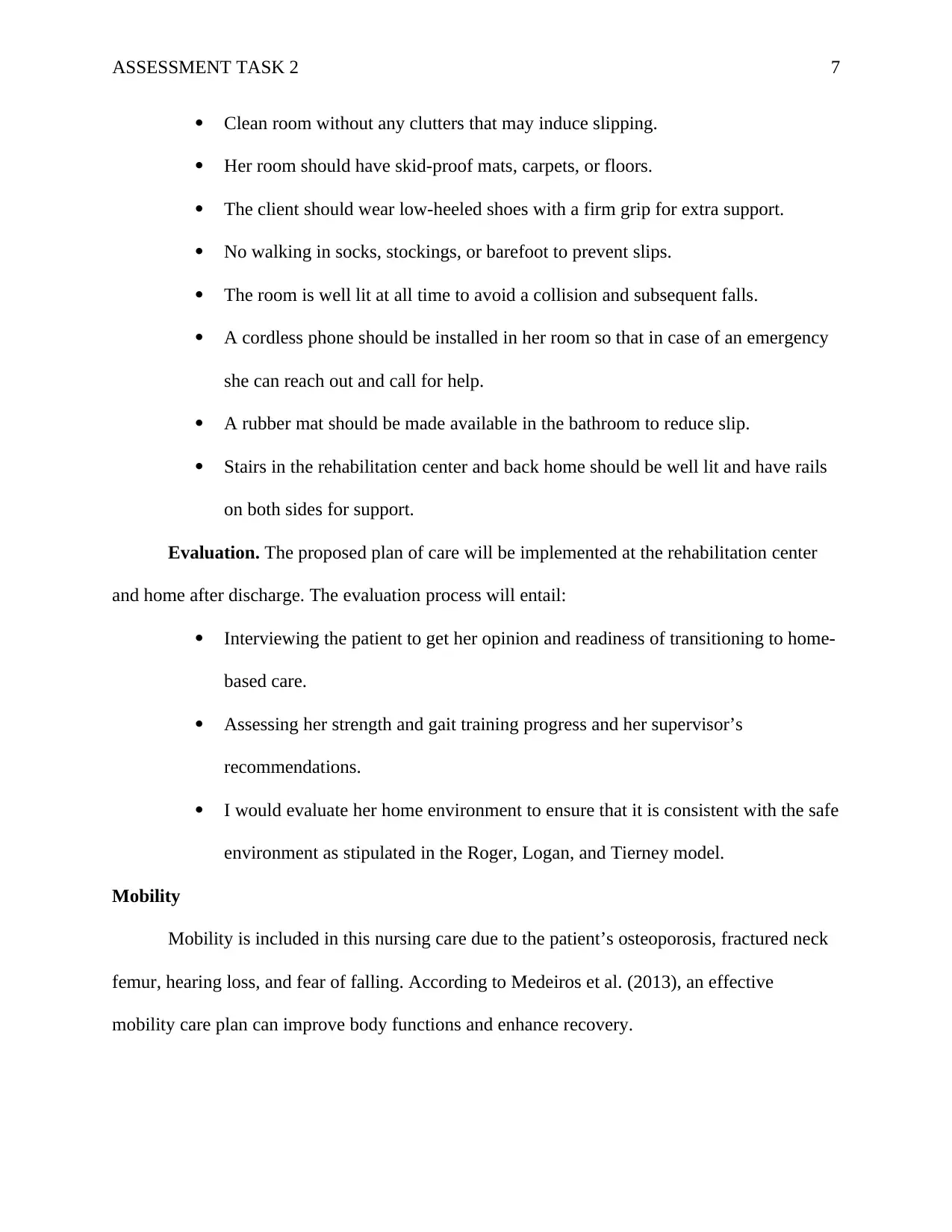
ASSESSMENT TASK 2 7
Clean room without any clutters that may induce slipping.
Her room should have skid-proof mats, carpets, or floors.
The client should wear low-heeled shoes with a firm grip for extra support.
No walking in socks, stockings, or barefoot to prevent slips.
The room is well lit at all time to avoid a collision and subsequent falls.
A cordless phone should be installed in her room so that in case of an emergency
she can reach out and call for help.
A rubber mat should be made available in the bathroom to reduce slip.
Stairs in the rehabilitation center and back home should be well lit and have rails
on both sides for support.
Evaluation. The proposed plan of care will be implemented at the rehabilitation center
and home after discharge. The evaluation process will entail:
Interviewing the patient to get her opinion and readiness of transitioning to home-
based care.
Assessing her strength and gait training progress and her supervisor’s
recommendations.
I would evaluate her home environment to ensure that it is consistent with the safe
environment as stipulated in the Roger, Logan, and Tierney model.
Mobility
Mobility is included in this nursing care due to the patient’s osteoporosis, fractured neck
femur, hearing loss, and fear of falling. According to Medeiros et al. (2013), an effective
mobility care plan can improve body functions and enhance recovery.
Clean room without any clutters that may induce slipping.
Her room should have skid-proof mats, carpets, or floors.
The client should wear low-heeled shoes with a firm grip for extra support.
No walking in socks, stockings, or barefoot to prevent slips.
The room is well lit at all time to avoid a collision and subsequent falls.
A cordless phone should be installed in her room so that in case of an emergency
she can reach out and call for help.
A rubber mat should be made available in the bathroom to reduce slip.
Stairs in the rehabilitation center and back home should be well lit and have rails
on both sides for support.
Evaluation. The proposed plan of care will be implemented at the rehabilitation center
and home after discharge. The evaluation process will entail:
Interviewing the patient to get her opinion and readiness of transitioning to home-
based care.
Assessing her strength and gait training progress and her supervisor’s
recommendations.
I would evaluate her home environment to ensure that it is consistent with the safe
environment as stipulated in the Roger, Logan, and Tierney model.
Mobility
Mobility is included in this nursing care due to the patient’s osteoporosis, fractured neck
femur, hearing loss, and fear of falling. According to Medeiros et al. (2013), an effective
mobility care plan can improve body functions and enhance recovery.
Paraphrase This Document
Need a fresh take? Get an instant paraphrase of this document with our AI Paraphraser
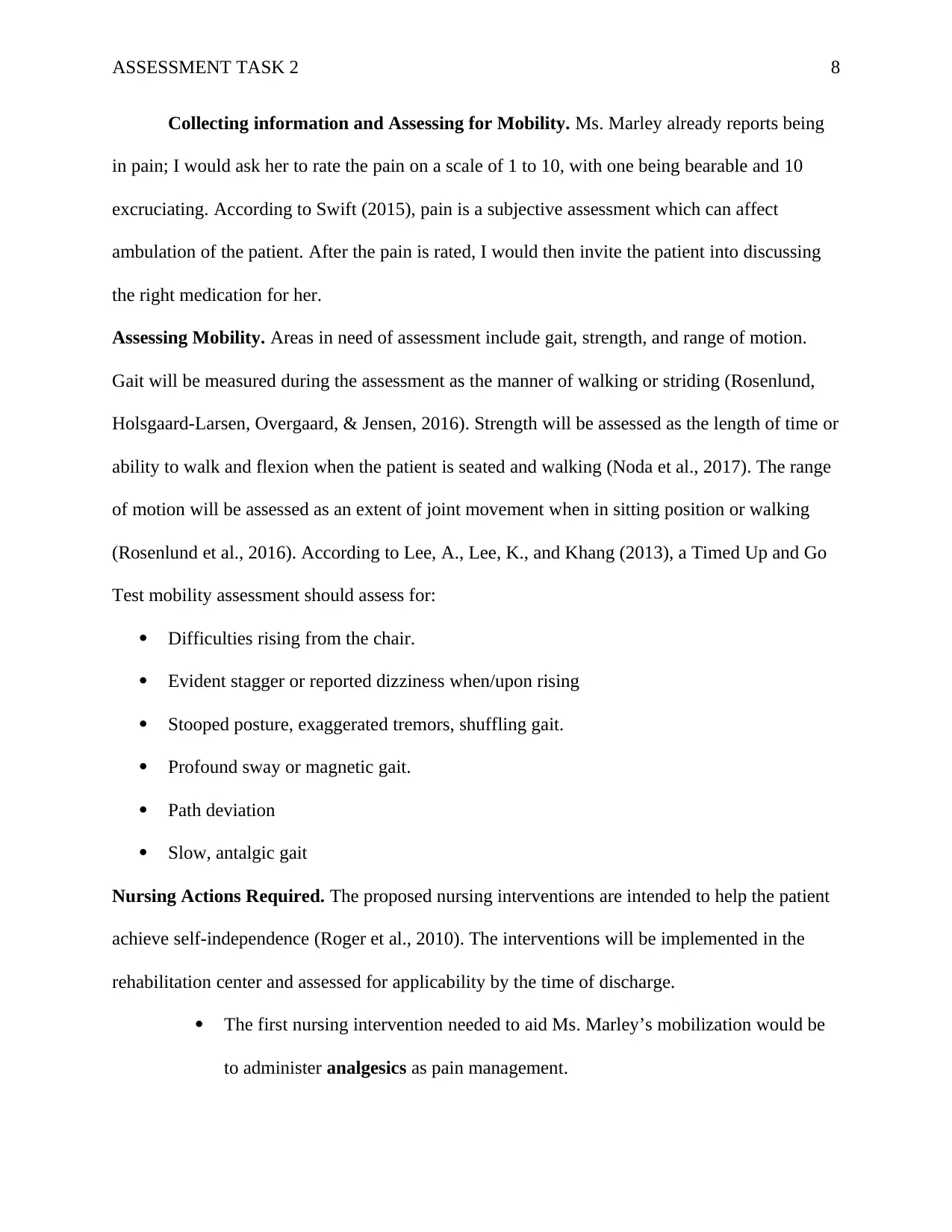
ASSESSMENT TASK 2 8
Collecting information and Assessing for Mobility. Ms. Marley already reports being
in pain; I would ask her to rate the pain on a scale of 1 to 10, with one being bearable and 10
excruciating. According to Swift (2015), pain is a subjective assessment which can affect
ambulation of the patient. After the pain is rated, I would then invite the patient into discussing
the right medication for her.
Assessing Mobility. Areas in need of assessment include gait, strength, and range of motion.
Gait will be measured during the assessment as the manner of walking or striding (Rosenlund,
Holsgaard-Larsen, Overgaard, & Jensen, 2016). Strength will be assessed as the length of time or
ability to walk and flexion when the patient is seated and walking (Noda et al., 2017). The range
of motion will be assessed as an extent of joint movement when in sitting position or walking
(Rosenlund et al., 2016). According to Lee, A., Lee, K., and Khang (2013), a Timed Up and Go
Test mobility assessment should assess for:
Difficulties rising from the chair.
Evident stagger or reported dizziness when/upon rising
Stooped posture, exaggerated tremors, shuffling gait.
Profound sway or magnetic gait.
Path deviation
Slow, antalgic gait
Nursing Actions Required. The proposed nursing interventions are intended to help the patient
achieve self-independence (Roger et al., 2010). The interventions will be implemented in the
rehabilitation center and assessed for applicability by the time of discharge.
The first nursing intervention needed to aid Ms. Marley’s mobilization would be
to administer analgesics as pain management.
Collecting information and Assessing for Mobility. Ms. Marley already reports being
in pain; I would ask her to rate the pain on a scale of 1 to 10, with one being bearable and 10
excruciating. According to Swift (2015), pain is a subjective assessment which can affect
ambulation of the patient. After the pain is rated, I would then invite the patient into discussing
the right medication for her.
Assessing Mobility. Areas in need of assessment include gait, strength, and range of motion.
Gait will be measured during the assessment as the manner of walking or striding (Rosenlund,
Holsgaard-Larsen, Overgaard, & Jensen, 2016). Strength will be assessed as the length of time or
ability to walk and flexion when the patient is seated and walking (Noda et al., 2017). The range
of motion will be assessed as an extent of joint movement when in sitting position or walking
(Rosenlund et al., 2016). According to Lee, A., Lee, K., and Khang (2013), a Timed Up and Go
Test mobility assessment should assess for:
Difficulties rising from the chair.
Evident stagger or reported dizziness when/upon rising
Stooped posture, exaggerated tremors, shuffling gait.
Profound sway or magnetic gait.
Path deviation
Slow, antalgic gait
Nursing Actions Required. The proposed nursing interventions are intended to help the patient
achieve self-independence (Roger et al., 2010). The interventions will be implemented in the
rehabilitation center and assessed for applicability by the time of discharge.
The first nursing intervention needed to aid Ms. Marley’s mobilization would be
to administer analgesics as pain management.
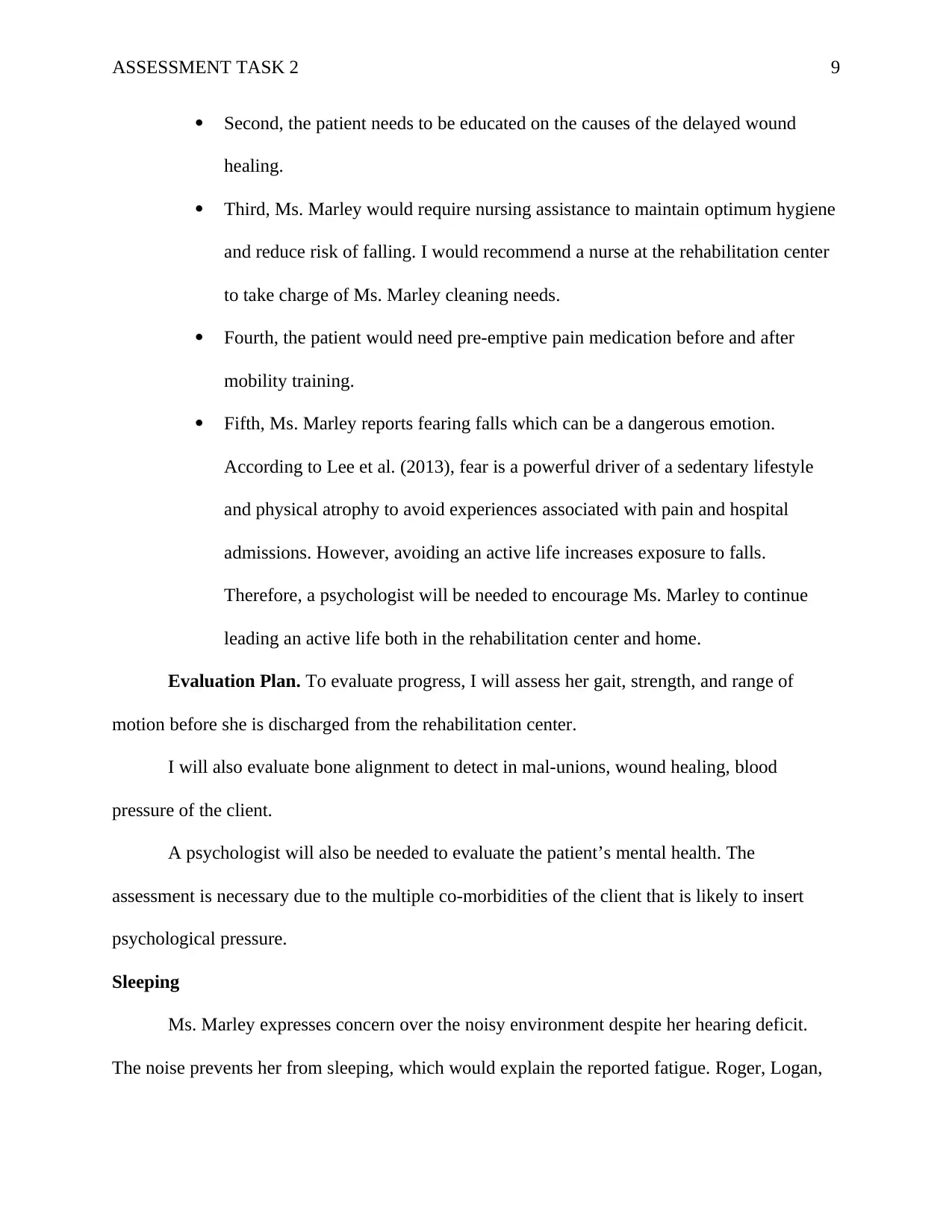
ASSESSMENT TASK 2 9
Second, the patient needs to be educated on the causes of the delayed wound
healing.
Third, Ms. Marley would require nursing assistance to maintain optimum hygiene
and reduce risk of falling. I would recommend a nurse at the rehabilitation center
to take charge of Ms. Marley cleaning needs.
Fourth, the patient would need pre-emptive pain medication before and after
mobility training.
Fifth, Ms. Marley reports fearing falls which can be a dangerous emotion.
According to Lee et al. (2013), fear is a powerful driver of a sedentary lifestyle
and physical atrophy to avoid experiences associated with pain and hospital
admissions. However, avoiding an active life increases exposure to falls.
Therefore, a psychologist will be needed to encourage Ms. Marley to continue
leading an active life both in the rehabilitation center and home.
Evaluation Plan. To evaluate progress, I will assess her gait, strength, and range of
motion before she is discharged from the rehabilitation center.
I will also evaluate bone alignment to detect in mal-unions, wound healing, blood
pressure of the client.
A psychologist will also be needed to evaluate the patient’s mental health. The
assessment is necessary due to the multiple co-morbidities of the client that is likely to insert
psychological pressure.
Sleeping
Ms. Marley expresses concern over the noisy environment despite her hearing deficit.
The noise prevents her from sleeping, which would explain the reported fatigue. Roger, Logan,
Second, the patient needs to be educated on the causes of the delayed wound
healing.
Third, Ms. Marley would require nursing assistance to maintain optimum hygiene
and reduce risk of falling. I would recommend a nurse at the rehabilitation center
to take charge of Ms. Marley cleaning needs.
Fourth, the patient would need pre-emptive pain medication before and after
mobility training.
Fifth, Ms. Marley reports fearing falls which can be a dangerous emotion.
According to Lee et al. (2013), fear is a powerful driver of a sedentary lifestyle
and physical atrophy to avoid experiences associated with pain and hospital
admissions. However, avoiding an active life increases exposure to falls.
Therefore, a psychologist will be needed to encourage Ms. Marley to continue
leading an active life both in the rehabilitation center and home.
Evaluation Plan. To evaluate progress, I will assess her gait, strength, and range of
motion before she is discharged from the rehabilitation center.
I will also evaluate bone alignment to detect in mal-unions, wound healing, blood
pressure of the client.
A psychologist will also be needed to evaluate the patient’s mental health. The
assessment is necessary due to the multiple co-morbidities of the client that is likely to insert
psychological pressure.
Sleeping
Ms. Marley expresses concern over the noisy environment despite her hearing deficit.
The noise prevents her from sleeping, which would explain the reported fatigue. Roger, Logan,
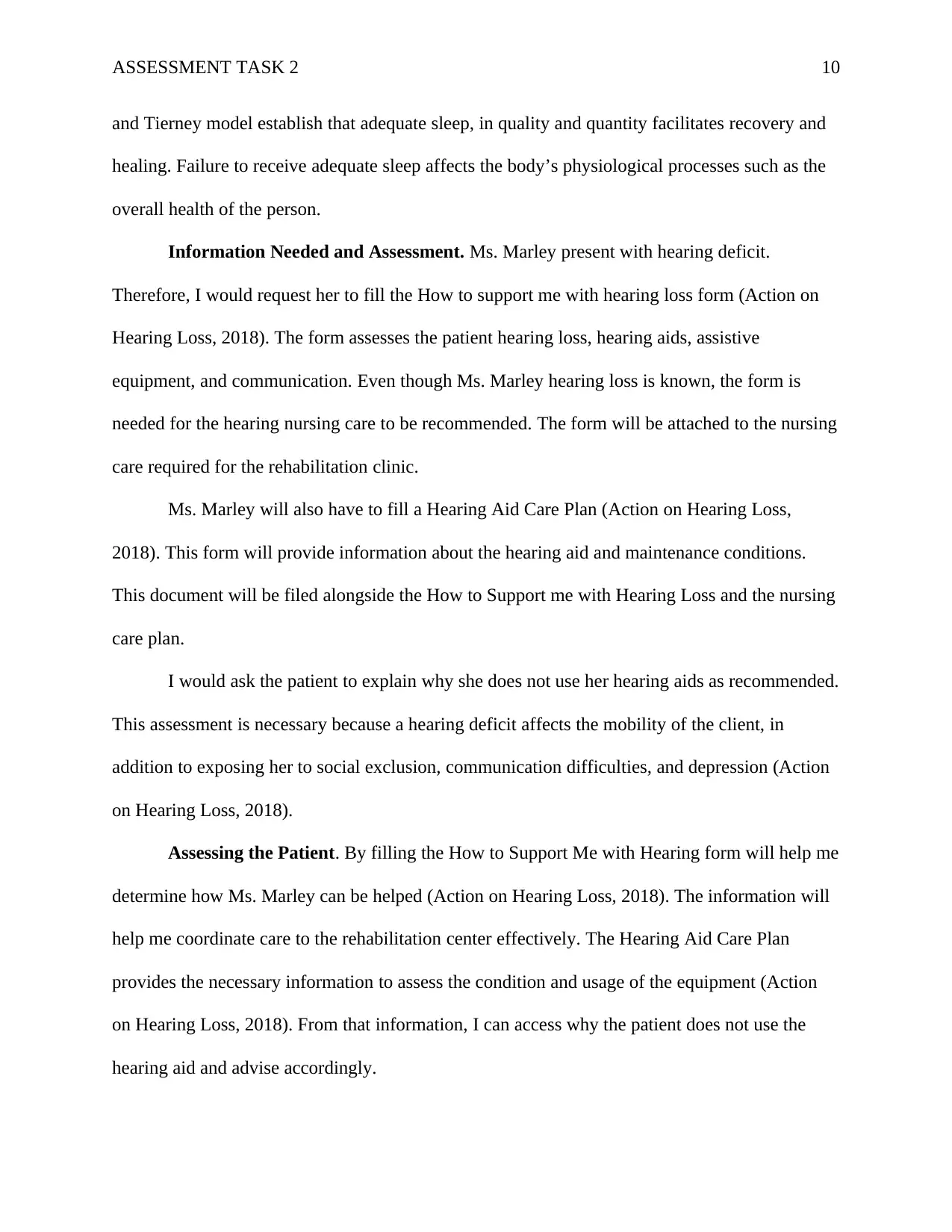
ASSESSMENT TASK 2 10
and Tierney model establish that adequate sleep, in quality and quantity facilitates recovery and
healing. Failure to receive adequate sleep affects the body’s physiological processes such as the
overall health of the person.
Information Needed and Assessment. Ms. Marley present with hearing deficit.
Therefore, I would request her to fill the How to support me with hearing loss form (Action on
Hearing Loss, 2018). The form assesses the patient hearing loss, hearing aids, assistive
equipment, and communication. Even though Ms. Marley hearing loss is known, the form is
needed for the hearing nursing care to be recommended. The form will be attached to the nursing
care required for the rehabilitation clinic.
Ms. Marley will also have to fill a Hearing Aid Care Plan (Action on Hearing Loss,
2018). This form will provide information about the hearing aid and maintenance conditions.
This document will be filed alongside the How to Support me with Hearing Loss and the nursing
care plan.
I would ask the patient to explain why she does not use her hearing aids as recommended.
This assessment is necessary because a hearing deficit affects the mobility of the client, in
addition to exposing her to social exclusion, communication difficulties, and depression (Action
on Hearing Loss, 2018).
Assessing the Patient. By filling the How to Support Me with Hearing form will help me
determine how Ms. Marley can be helped (Action on Hearing Loss, 2018). The information will
help me coordinate care to the rehabilitation center effectively. The Hearing Aid Care Plan
provides the necessary information to assess the condition and usage of the equipment (Action
on Hearing Loss, 2018). From that information, I can access why the patient does not use the
hearing aid and advise accordingly.
and Tierney model establish that adequate sleep, in quality and quantity facilitates recovery and
healing. Failure to receive adequate sleep affects the body’s physiological processes such as the
overall health of the person.
Information Needed and Assessment. Ms. Marley present with hearing deficit.
Therefore, I would request her to fill the How to support me with hearing loss form (Action on
Hearing Loss, 2018). The form assesses the patient hearing loss, hearing aids, assistive
equipment, and communication. Even though Ms. Marley hearing loss is known, the form is
needed for the hearing nursing care to be recommended. The form will be attached to the nursing
care required for the rehabilitation clinic.
Ms. Marley will also have to fill a Hearing Aid Care Plan (Action on Hearing Loss,
2018). This form will provide information about the hearing aid and maintenance conditions.
This document will be filed alongside the How to Support me with Hearing Loss and the nursing
care plan.
I would ask the patient to explain why she does not use her hearing aids as recommended.
This assessment is necessary because a hearing deficit affects the mobility of the client, in
addition to exposing her to social exclusion, communication difficulties, and depression (Action
on Hearing Loss, 2018).
Assessing the Patient. By filling the How to Support Me with Hearing form will help me
determine how Ms. Marley can be helped (Action on Hearing Loss, 2018). The information will
help me coordinate care to the rehabilitation center effectively. The Hearing Aid Care Plan
provides the necessary information to assess the condition and usage of the equipment (Action
on Hearing Loss, 2018). From that information, I can access why the patient does not use the
hearing aid and advise accordingly.
Secure Best Marks with AI Grader
Need help grading? Try our AI Grader for instant feedback on your assignments.
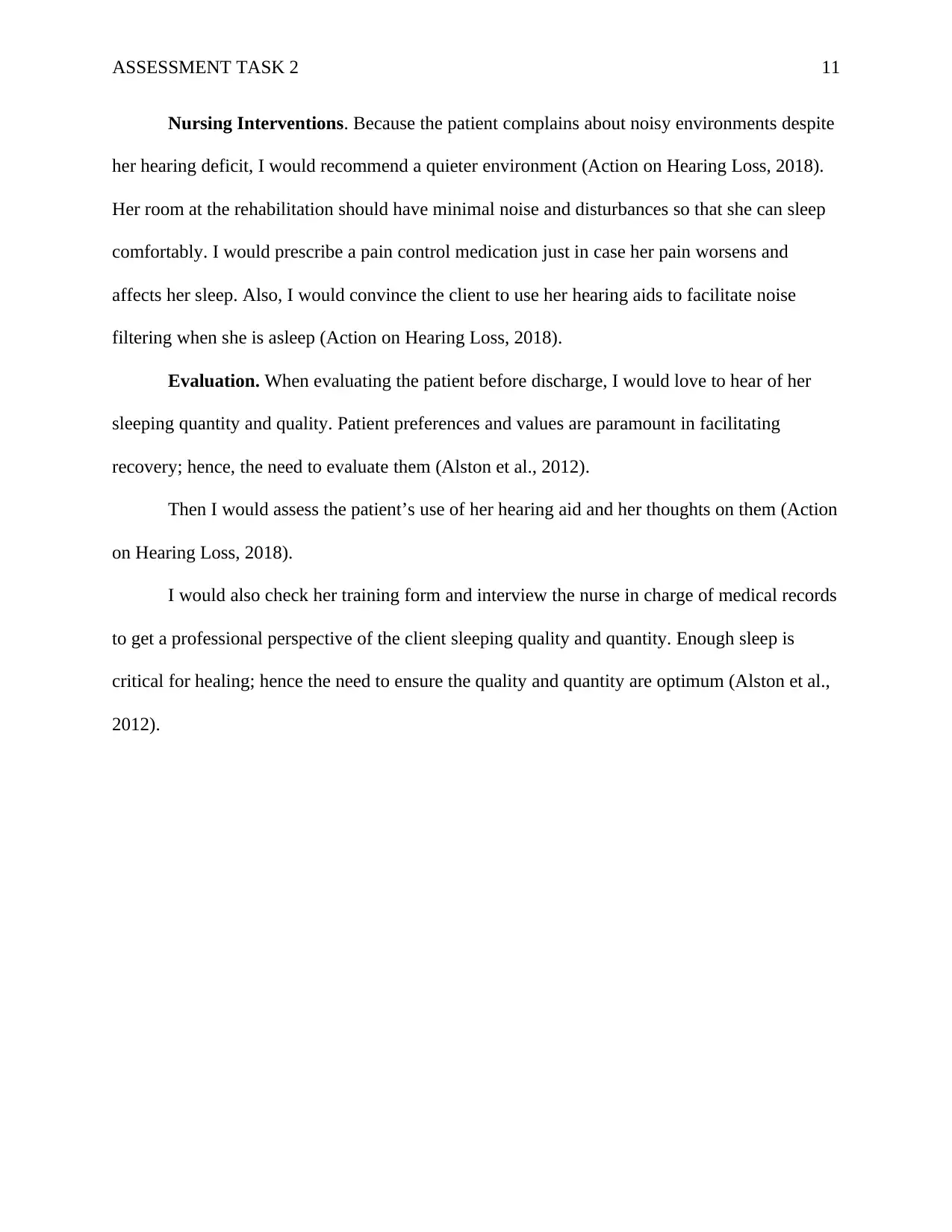
ASSESSMENT TASK 2 11
Nursing Interventions. Because the patient complains about noisy environments despite
her hearing deficit, I would recommend a quieter environment (Action on Hearing Loss, 2018).
Her room at the rehabilitation should have minimal noise and disturbances so that she can sleep
comfortably. I would prescribe a pain control medication just in case her pain worsens and
affects her sleep. Also, I would convince the client to use her hearing aids to facilitate noise
filtering when she is asleep (Action on Hearing Loss, 2018).
Evaluation. When evaluating the patient before discharge, I would love to hear of her
sleeping quantity and quality. Patient preferences and values are paramount in facilitating
recovery; hence, the need to evaluate them (Alston et al., 2012).
Then I would assess the patient’s use of her hearing aid and her thoughts on them (Action
on Hearing Loss, 2018).
I would also check her training form and interview the nurse in charge of medical records
to get a professional perspective of the client sleeping quality and quantity. Enough sleep is
critical for healing; hence the need to ensure the quality and quantity are optimum (Alston et al.,
2012).
Nursing Interventions. Because the patient complains about noisy environments despite
her hearing deficit, I would recommend a quieter environment (Action on Hearing Loss, 2018).
Her room at the rehabilitation should have minimal noise and disturbances so that she can sleep
comfortably. I would prescribe a pain control medication just in case her pain worsens and
affects her sleep. Also, I would convince the client to use her hearing aids to facilitate noise
filtering when she is asleep (Action on Hearing Loss, 2018).
Evaluation. When evaluating the patient before discharge, I would love to hear of her
sleeping quantity and quality. Patient preferences and values are paramount in facilitating
recovery; hence, the need to evaluate them (Alston et al., 2012).
Then I would assess the patient’s use of her hearing aid and her thoughts on them (Action
on Hearing Loss, 2018).
I would also check her training form and interview the nurse in charge of medical records
to get a professional perspective of the client sleeping quality and quantity. Enough sleep is
critical for healing; hence the need to ensure the quality and quantity are optimum (Alston et al.,
2012).
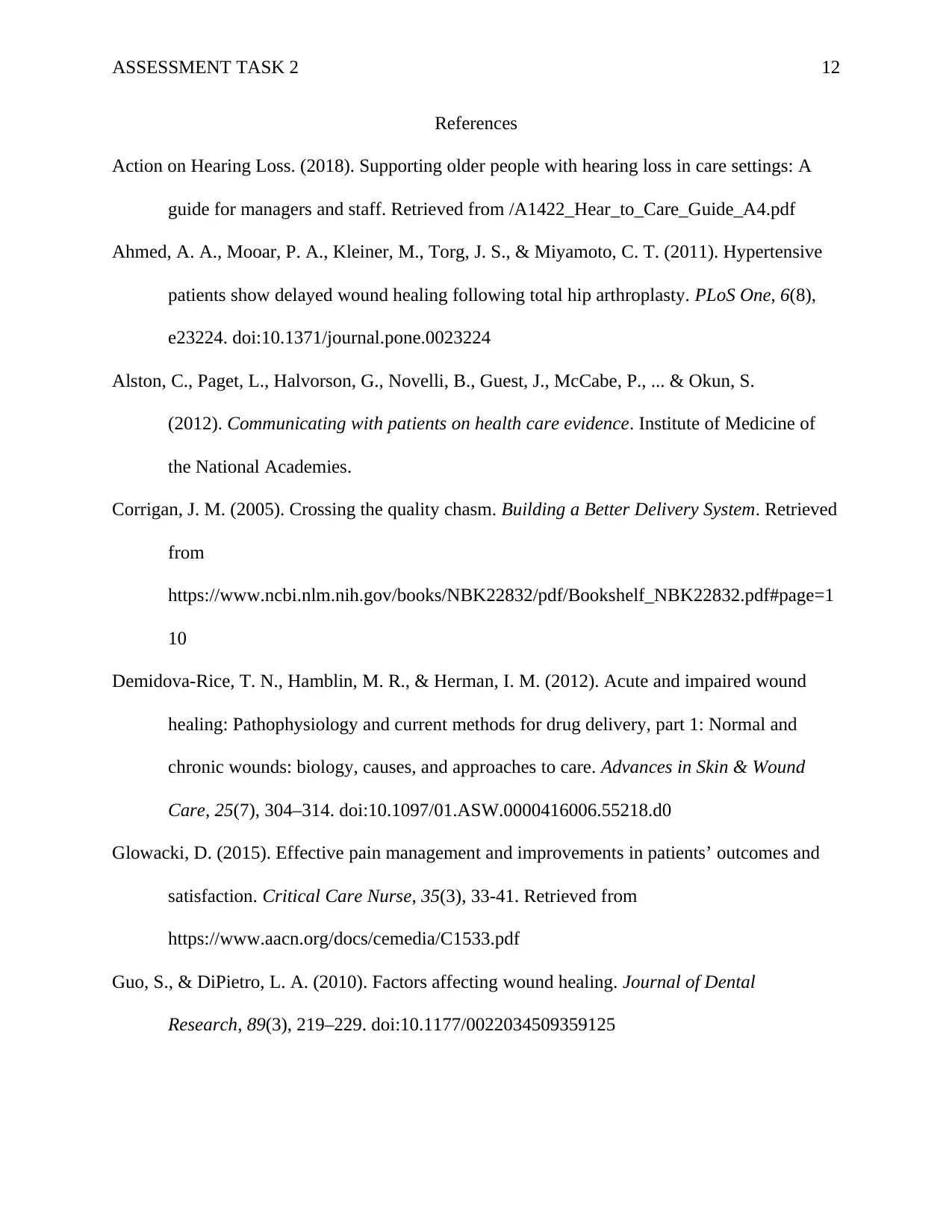
ASSESSMENT TASK 2 12
References
Action on Hearing Loss. (2018). Supporting older people with hearing loss in care settings: A
guide for managers and staff. Retrieved from /A1422_Hear_to_Care_Guide_A4.pdf
Ahmed, A. A., Mooar, P. A., Kleiner, M., Torg, J. S., & Miyamoto, C. T. (2011). Hypertensive
patients show delayed wound healing following total hip arthroplasty. PLoS One, 6(8),
e23224. doi:10.1371/journal.pone.0023224
Alston, C., Paget, L., Halvorson, G., Novelli, B., Guest, J., McCabe, P., ... & Okun, S.
(2012). Communicating with patients on health care evidence. Institute of Medicine of
the National Academies.
Corrigan, J. M. (2005). Crossing the quality chasm. Building a Better Delivery System. Retrieved
from
https://www.ncbi.nlm.nih.gov/books/NBK22832/pdf/Bookshelf_NBK22832.pdf#page=1
10
Demidova-Rice, T. N., Hamblin, M. R., & Herman, I. M. (2012). Acute and impaired wound
healing: Pathophysiology and current methods for drug delivery, part 1: Normal and
chronic wounds: biology, causes, and approaches to care. Advances in Skin & Wound
Care, 25(7), 304–314. doi:10.1097/01.ASW.0000416006.55218.d0
Glowacki, D. (2015). Effective pain management and improvements in patients’ outcomes and
satisfaction. Critical Care Nurse, 35(3), 33-41. Retrieved from
https://www.aacn.org/docs/cemedia/C1533.pdf
Guo, S., & DiPietro, L. A. (2010). Factors affecting wound healing. Journal of Dental
Research, 89(3), 219–229. doi:10.1177/0022034509359125
References
Action on Hearing Loss. (2018). Supporting older people with hearing loss in care settings: A
guide for managers and staff. Retrieved from /A1422_Hear_to_Care_Guide_A4.pdf
Ahmed, A. A., Mooar, P. A., Kleiner, M., Torg, J. S., & Miyamoto, C. T. (2011). Hypertensive
patients show delayed wound healing following total hip arthroplasty. PLoS One, 6(8),
e23224. doi:10.1371/journal.pone.0023224
Alston, C., Paget, L., Halvorson, G., Novelli, B., Guest, J., McCabe, P., ... & Okun, S.
(2012). Communicating with patients on health care evidence. Institute of Medicine of
the National Academies.
Corrigan, J. M. (2005). Crossing the quality chasm. Building a Better Delivery System. Retrieved
from
https://www.ncbi.nlm.nih.gov/books/NBK22832/pdf/Bookshelf_NBK22832.pdf#page=1
10
Demidova-Rice, T. N., Hamblin, M. R., & Herman, I. M. (2012). Acute and impaired wound
healing: Pathophysiology and current methods for drug delivery, part 1: Normal and
chronic wounds: biology, causes, and approaches to care. Advances in Skin & Wound
Care, 25(7), 304–314. doi:10.1097/01.ASW.0000416006.55218.d0
Glowacki, D. (2015). Effective pain management and improvements in patients’ outcomes and
satisfaction. Critical Care Nurse, 35(3), 33-41. Retrieved from
https://www.aacn.org/docs/cemedia/C1533.pdf
Guo, S., & DiPietro, L. A. (2010). Factors affecting wound healing. Journal of Dental
Research, 89(3), 219–229. doi:10.1177/0022034509359125
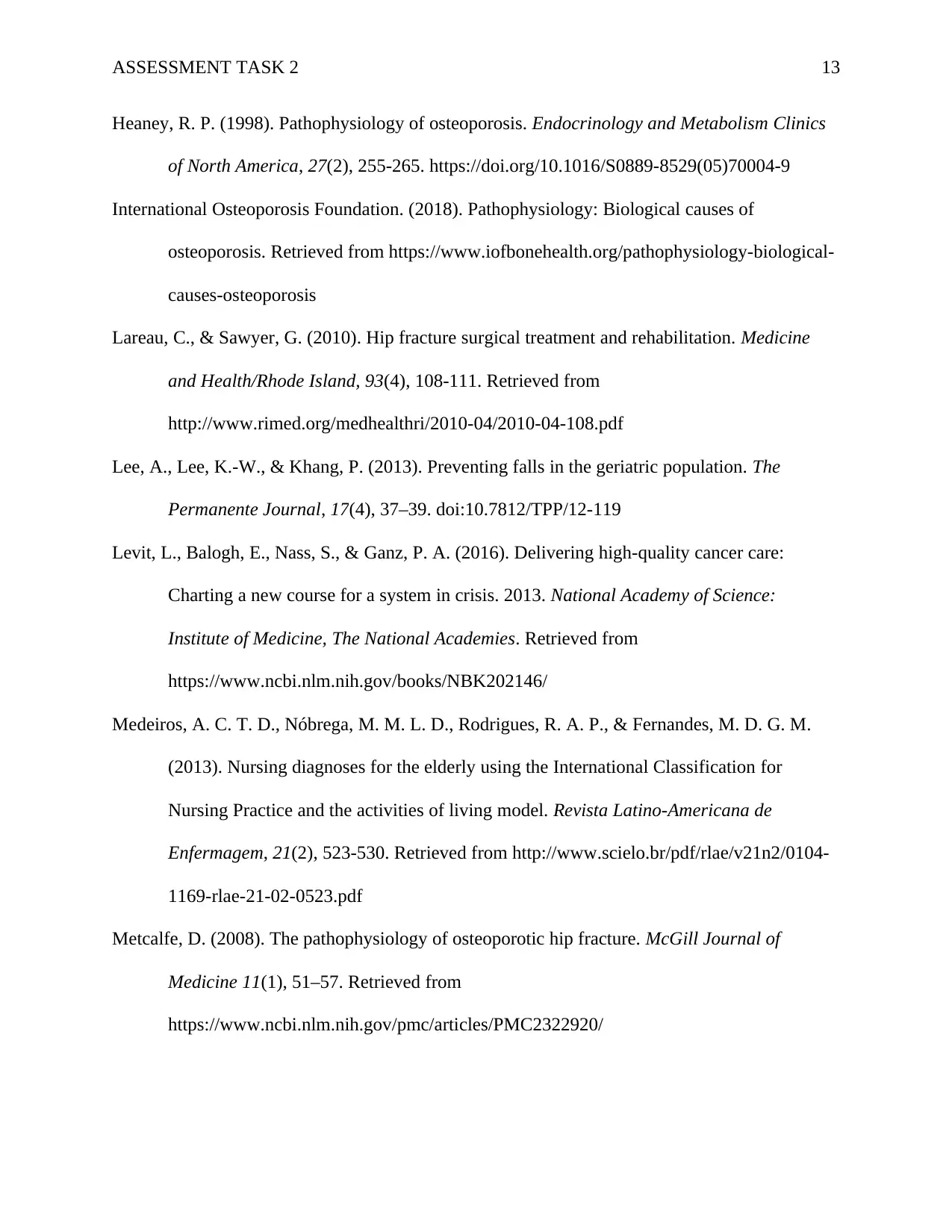
ASSESSMENT TASK 2 13
Heaney, R. P. (1998). Pathophysiology of osteoporosis. Endocrinology and Metabolism Clinics
of North America, 27(2), 255-265. https://doi.org/10.1016/S0889-8529(05)70004-9
International Osteoporosis Foundation. (2018). Pathophysiology: Biological causes of
osteoporosis. Retrieved from https://www.iofbonehealth.org/pathophysiology-biological-
causes-osteoporosis
Lareau, C., & Sawyer, G. (2010). Hip fracture surgical treatment and rehabilitation. Medicine
and Health/Rhode Island, 93(4), 108-111. Retrieved from
http://www.rimed.org/medhealthri/2010-04/2010-04-108.pdf
Lee, A., Lee, K.-W., & Khang, P. (2013). Preventing falls in the geriatric population. The
Permanente Journal, 17(4), 37–39. doi:10.7812/TPP/12-119
Levit, L., Balogh, E., Nass, S., & Ganz, P. A. (2016). Delivering high-quality cancer care:
Charting a new course for a system in crisis. 2013. National Academy of Science:
Institute of Medicine, The National Academies. Retrieved from
https://www.ncbi.nlm.nih.gov/books/NBK202146/
Medeiros, A. C. T. D., Nóbrega, M. M. L. D., Rodrigues, R. A. P., & Fernandes, M. D. G. M.
(2013). Nursing diagnoses for the elderly using the International Classification for
Nursing Practice and the activities of living model. Revista Latino-Americana de
Enfermagem, 21(2), 523-530. Retrieved from http://www.scielo.br/pdf/rlae/v21n2/0104-
1169-rlae-21-02-0523.pdf
Metcalfe, D. (2008). The pathophysiology of osteoporotic hip fracture. McGill Journal of
Medicine 11(1), 51–57. Retrieved from
https://www.ncbi.nlm.nih.gov/pmc/articles/PMC2322920/
Heaney, R. P. (1998). Pathophysiology of osteoporosis. Endocrinology and Metabolism Clinics
of North America, 27(2), 255-265. https://doi.org/10.1016/S0889-8529(05)70004-9
International Osteoporosis Foundation. (2018). Pathophysiology: Biological causes of
osteoporosis. Retrieved from https://www.iofbonehealth.org/pathophysiology-biological-
causes-osteoporosis
Lareau, C., & Sawyer, G. (2010). Hip fracture surgical treatment and rehabilitation. Medicine
and Health/Rhode Island, 93(4), 108-111. Retrieved from
http://www.rimed.org/medhealthri/2010-04/2010-04-108.pdf
Lee, A., Lee, K.-W., & Khang, P. (2013). Preventing falls in the geriatric population. The
Permanente Journal, 17(4), 37–39. doi:10.7812/TPP/12-119
Levit, L., Balogh, E., Nass, S., & Ganz, P. A. (2016). Delivering high-quality cancer care:
Charting a new course for a system in crisis. 2013. National Academy of Science:
Institute of Medicine, The National Academies. Retrieved from
https://www.ncbi.nlm.nih.gov/books/NBK202146/
Medeiros, A. C. T. D., Nóbrega, M. M. L. D., Rodrigues, R. A. P., & Fernandes, M. D. G. M.
(2013). Nursing diagnoses for the elderly using the International Classification for
Nursing Practice and the activities of living model. Revista Latino-Americana de
Enfermagem, 21(2), 523-530. Retrieved from http://www.scielo.br/pdf/rlae/v21n2/0104-
1169-rlae-21-02-0523.pdf
Metcalfe, D. (2008). The pathophysiology of osteoporotic hip fracture. McGill Journal of
Medicine 11(1), 51–57. Retrieved from
https://www.ncbi.nlm.nih.gov/pmc/articles/PMC2322920/
Paraphrase This Document
Need a fresh take? Get an instant paraphrase of this document with our AI Paraphraser
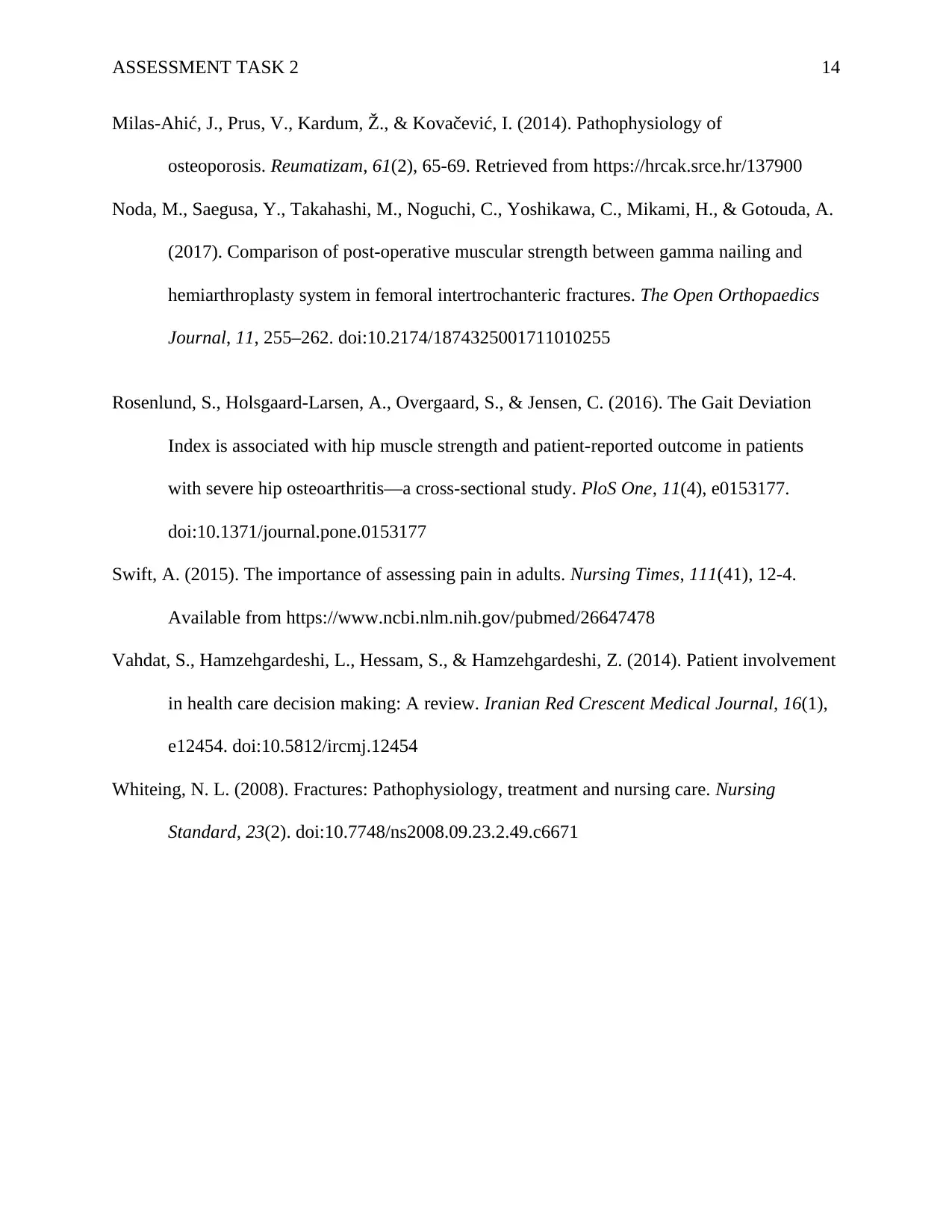
ASSESSMENT TASK 2 14
Milas-Ahić, J., Prus, V., Kardum, Ž., & Kovačević, I. (2014). Pathophysiology of
osteoporosis. Reumatizam, 61(2), 65-69. Retrieved from https://hrcak.srce.hr/137900
Noda, M., Saegusa, Y., Takahashi, M., Noguchi, C., Yoshikawa, C., Mikami, H., & Gotouda, A.
(2017). Comparison of post-operative muscular strength between gamma nailing and
hemiarthroplasty system in femoral intertrochanteric fractures. The Open Orthopaedics
Journal, 11, 255–262. doi:10.2174/1874325001711010255
Rosenlund, S., Holsgaard-Larsen, A., Overgaard, S., & Jensen, C. (2016). The Gait Deviation
Index is associated with hip muscle strength and patient-reported outcome in patients
with severe hip osteoarthritis—a cross-sectional study. PloS One, 11(4), e0153177.
doi:10.1371/journal.pone.0153177
Swift, A. (2015). The importance of assessing pain in adults. Nursing Times, 111(41), 12-4.
Available from https://www.ncbi.nlm.nih.gov/pubmed/26647478
Vahdat, S., Hamzehgardeshi, L., Hessam, S., & Hamzehgardeshi, Z. (2014). Patient involvement
in health care decision making: A review. Iranian Red Crescent Medical Journal, 16(1),
e12454. doi:10.5812/ircmj.12454
Whiteing, N. L. (2008). Fractures: Pathophysiology, treatment and nursing care. Nursing
Standard, 23(2). doi:10.7748/ns2008.09.23.2.49.c6671
Milas-Ahić, J., Prus, V., Kardum, Ž., & Kovačević, I. (2014). Pathophysiology of
osteoporosis. Reumatizam, 61(2), 65-69. Retrieved from https://hrcak.srce.hr/137900
Noda, M., Saegusa, Y., Takahashi, M., Noguchi, C., Yoshikawa, C., Mikami, H., & Gotouda, A.
(2017). Comparison of post-operative muscular strength between gamma nailing and
hemiarthroplasty system in femoral intertrochanteric fractures. The Open Orthopaedics
Journal, 11, 255–262. doi:10.2174/1874325001711010255
Rosenlund, S., Holsgaard-Larsen, A., Overgaard, S., & Jensen, C. (2016). The Gait Deviation
Index is associated with hip muscle strength and patient-reported outcome in patients
with severe hip osteoarthritis—a cross-sectional study. PloS One, 11(4), e0153177.
doi:10.1371/journal.pone.0153177
Swift, A. (2015). The importance of assessing pain in adults. Nursing Times, 111(41), 12-4.
Available from https://www.ncbi.nlm.nih.gov/pubmed/26647478
Vahdat, S., Hamzehgardeshi, L., Hessam, S., & Hamzehgardeshi, Z. (2014). Patient involvement
in health care decision making: A review. Iranian Red Crescent Medical Journal, 16(1),
e12454. doi:10.5812/ircmj.12454
Whiteing, N. L. (2008). Fractures: Pathophysiology, treatment and nursing care. Nursing
Standard, 23(2). doi:10.7748/ns2008.09.23.2.49.c6671
1 out of 14
Your All-in-One AI-Powered Toolkit for Academic Success.
+13062052269
info@desklib.com
Available 24*7 on WhatsApp / Email
![[object Object]](/_next/static/media/star-bottom.7253800d.svg)
Unlock your academic potential
© 2024 | Zucol Services PVT LTD | All rights reserved.